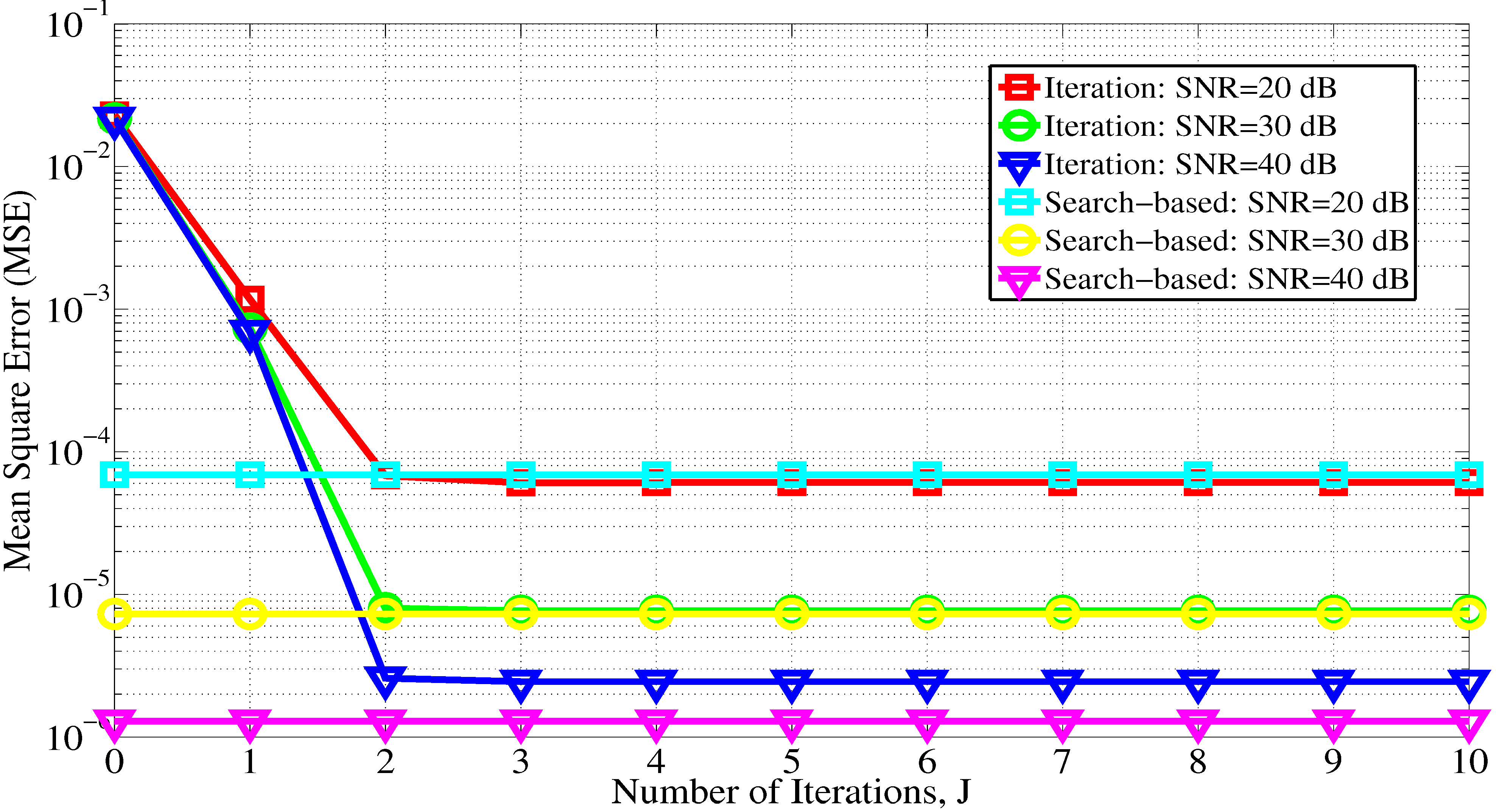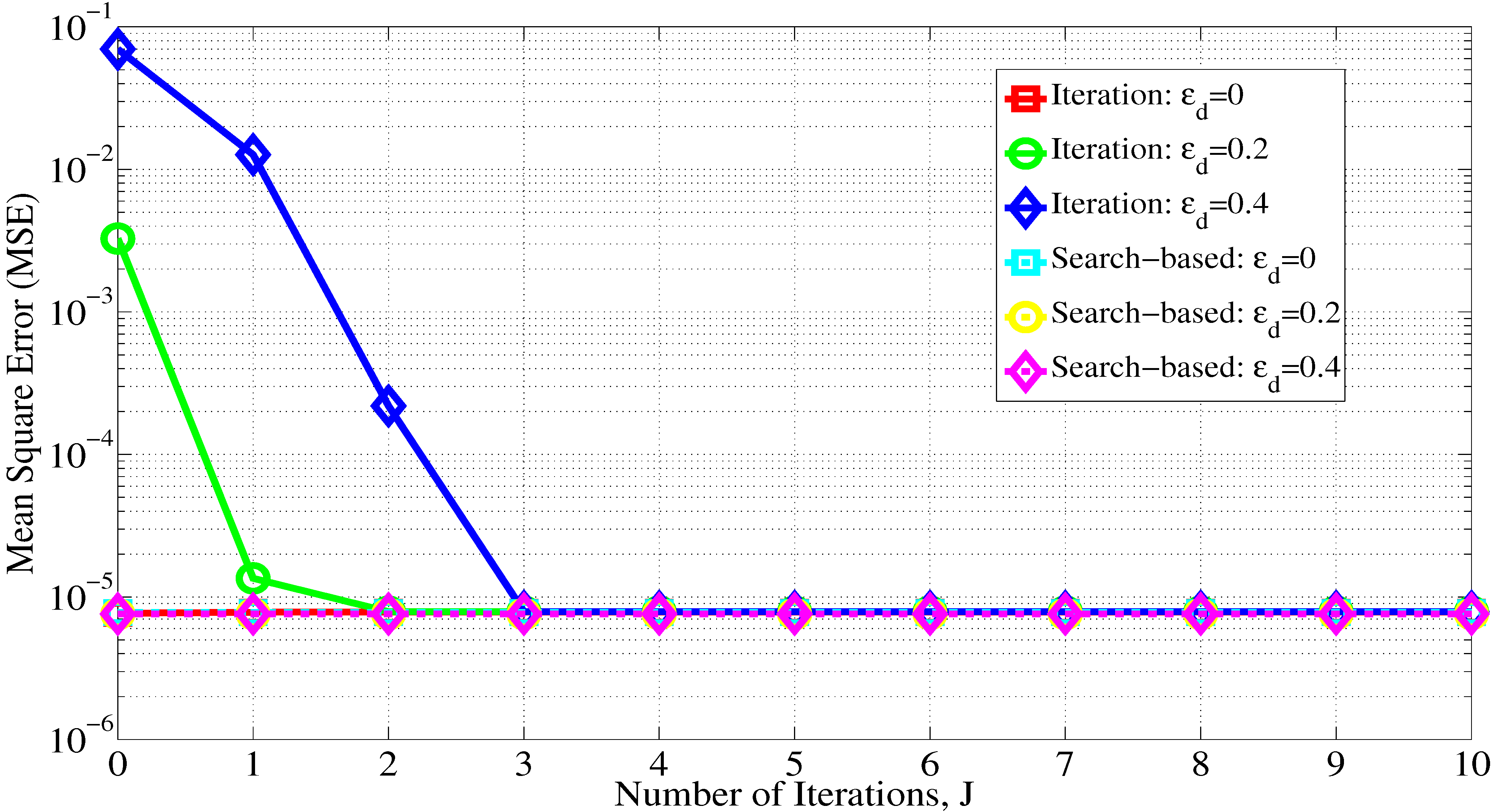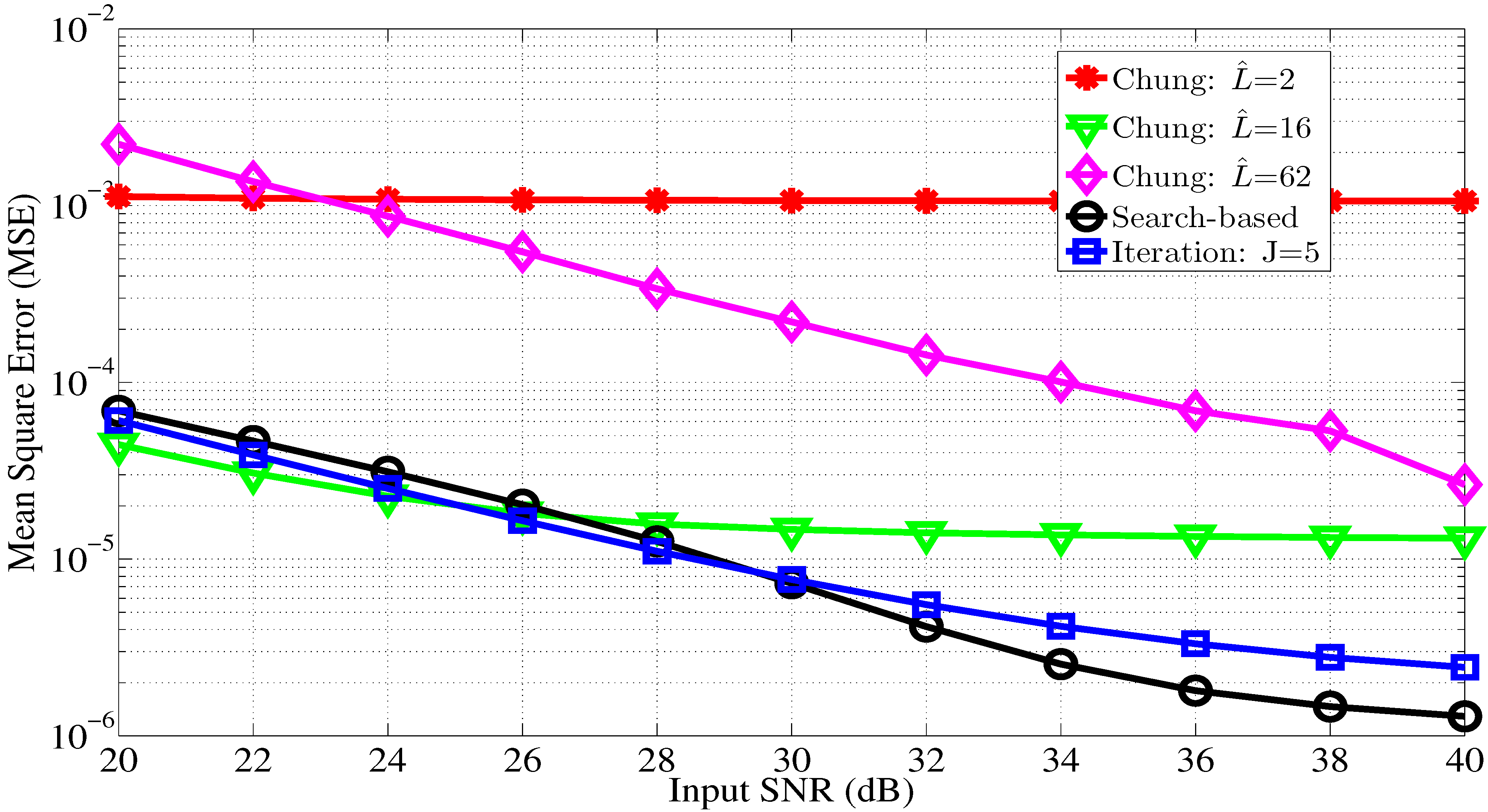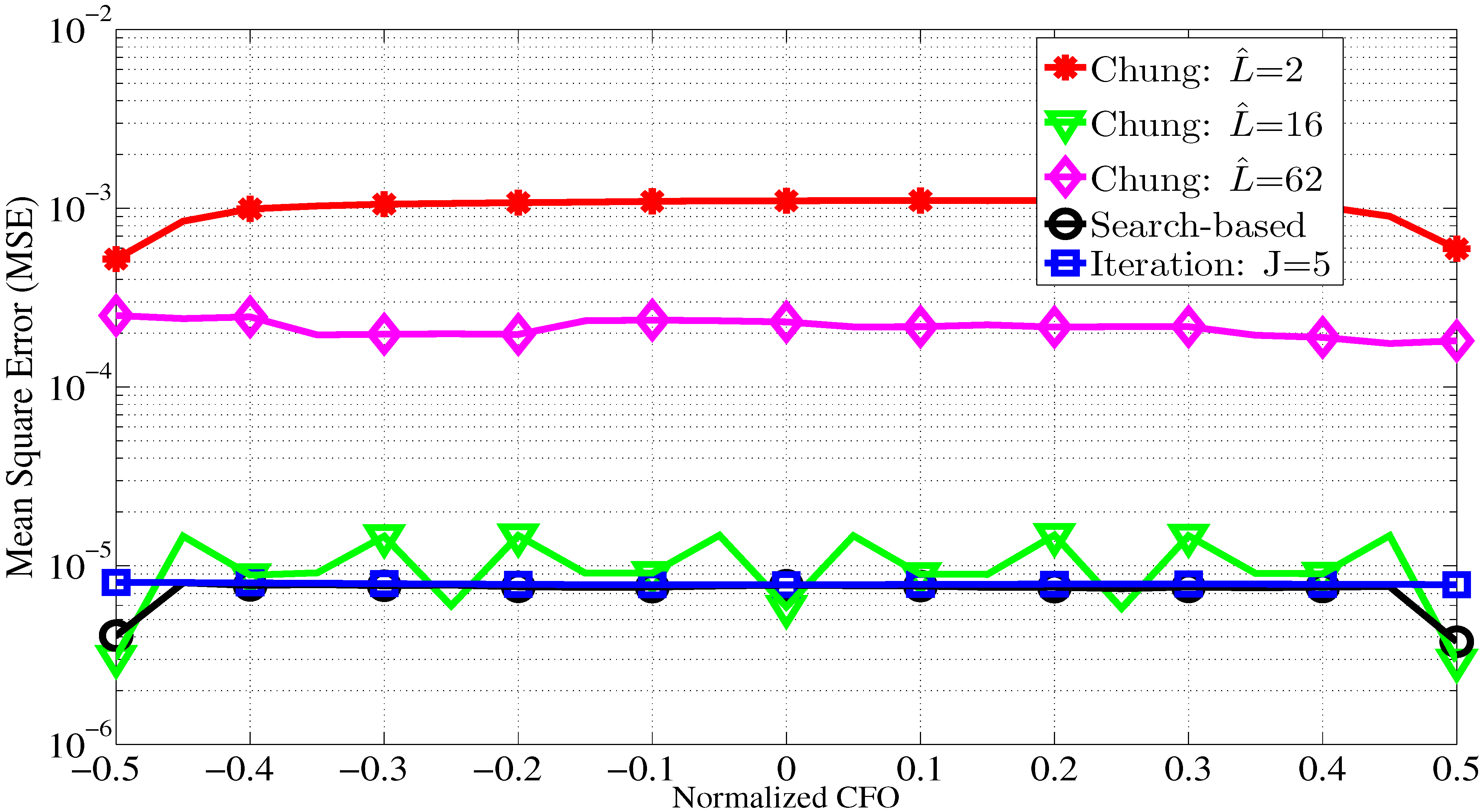1. Introduction
In wireless communications, the carrier frequency offset (CFO) [
1,
2] is primarily caused when the frequencies of the oscillators between the transmitting and receiving ends do not match or there is a Doppler frequency shift that is proportional to the carrier frequency, as well as to the moving speed of the mobile unit. For orthogonal frequency division multiplexing (OFDM) systems [
3,
4], the quality of the signal transmission is liable to degrade in the case of the existence of CFO. This is because CFO destroys the orthogonality between the subcarriers and, thus, brings about the signal distortion in OFDM systems. Since multi-carrier systems are very sensitive to the subcarrier synchronization error, it is essential to provide an accurate estimation for compensating the CFO. Otherwise, it is difficult to develop an OFDM system that is able to meet the elementary requirement of acceptable communication link quality. Therefore, CFO estimation for OFDM attracts much attention and is an active area of research.
In the past, a number of works (e.g., [
1,
2,
3,
4,
5,
6,
7,
8,
9,
10,
11,
12,
13,
14,
15,
16,
17]) have been devoted to the CFO estimation techniques. The least square (LS) criterion is used in [
8] for CFO estimation. Hebley [
7] presented a CFO estimator based on the maximum-likelihood (ML) criterion while assuming the training sequences and channel statistics are known. In [
9], the ML criterion is further employed for the joint estimation of channel and CFO. In [
1,
10,
11], CFO estimators were developed using a training sequence with two or multiple identical components. By using one OFDM symbol with
M identical components, the CFO estimation scheme in [
11] expands the estimation range to
M subcarrier spacing for reducing the implementation cost, since the wider the estimation range is, the lower the precision of the employed oscillator will be. However, the expense of the scheme [
11] is the increase of the computational complexity, especially for a large
M. The estimation range can be further expanded by using one more OFDM symbol [
12] while sacrificing the transmission efficiency. The CFO estimation algorithms with the cyclic prefix (CP) technique [
13], which either use a special training sequence [
14] or a pilot signal [
15], have been presented. One of the most commonly used is to employ the subspace estimation algorithm of the singular value decomposition (SVD) [
16] and the ML criterion [
17]. On the other hand, it is commonly assumed that the channel side information is unavailable to the CFO estimator, and CFO estimation can also be reached by employing the inherent structure of OFDM signals. This is generally categorized into the field of blind approaches. For instance, the ML-based CFO estimator is implemented by using correlation operations, as the training signals are periodic and unknown [
1,
10]. The blind CFO estimation has received a great amount of attention because of its bandwidth efficiency. However, the blind schemes degrade in performance significantly, especially when the length of the channel impulse response is large. In practice, many channel estimation and space-time coding schemes [
18] require the channel statistics information. For these systems, the availability of channel statistics information can be expected for CFO estimation in OFDM.
The objective of this paper is to present a CFO estimation technique, which is aided with pilot symbols, for OFDM transmission. The results obtained from this novel approach would provide two major contributions. For the traditional line search methods of CFO, it is often assumed that the channel order is known prior to the CFO estimate. However, this assumption may not be realistic, while the channel characteristic is difficult to be acquired promptly. First, we discard the assumption and modified the traditional CFO line search method by introducing an interpolation technique to attempt reconstructing full-dimensional channel frequency responses for an OFDM system with pilots. We derived the theoretical analysis in this study and reached some beneficial statistics of the estimation scheme. Based on these obtained analytical results, it can be found that the CFO estimate criterion is equivalent to discovering the frequency that achieves the minimum residual channel energy (CRE). Secondarily, we efficiently reduced the implementation complexity of the proposed CFO estimator by means of developing a simplified scheme without using the exhaustive CFO search method. Such a scheme allows the estimator to need less amount of computation during the data process than that required by a conventional line search approach. In spite of providing a lower complexity than that of a conventional technique, the alternative scheme operates at the expense of a little amount of estimate accuracy loss. Therefore, we further applied an iteration technique to compensate the estimate accuracy loss, which results from the necessary approximation in the analytical process of the estimate statistics.
The organization of the rest of the paper is as follows.
Section 2 depicts the mathematical models for the received data while considering the presence of CFO and provides an essential review of the conventional estimate approach presented by Chung [
19]. In
Section 3, we first propose an improved search-based CFO estimator while assuming the channel order is not reached. Next, an iterative algorithm is presented to reduce the computational complexity of the proposed estimator. To have a clear insight of how much complexity can be saved, numerical comparison of the computational complexities among all of the concerned schemes is also included in this section. In
Section 4, we provide the computer simulation results to demonstrate the performance advantages of the proposed schemes over Chung’s approach. Finally, the conclusion is reported in
Section 5.
The notations used in this paper are defined as followed: vectors (matrices) are typed with boldface letters. , and represent an identity matrix, an all-zero matrix and an all-zero vector, respectively. is a diagonal matrix with the diagonal entries taken from the vector . , , and the complex conjugate, transpose, Hermitian transpose and trace operations, respectively. The -th entry of matrix is denoted by . In addition, , and denote the real part of a complex number, the taken ensemble average and the Frobenius norm operator, respectively.
2. Signal Model
For a classical OFDM system, we consider that it has a total bandwidth composed of
N subcarriers and employs the technique of pilot-based signal correction, in which quadrature amplitude modulation (QAM) transmission is utilized over multipath fading channels. Let the total
K pilot symbols and
data symbols be modulated each by an individual subcarrier, such that the inter-carrier interference is absent. The modulated symbols
are processed by the inverse fast Fourier transformer (IFFT), and then transformed into the time-domain signals obtained by
, where
denotes the FFT matrix with the
-th entry being
. For a channel of maximum delay spread
L, the OFDM symbol requires a cyclic prefix (CP) of length
so as to eliminate the inter-symbol interference (ISI). After the CP is removed at the receiver end, the received OFDM symbols are then FFT processed. In the presence of CFO, the received symbol block is given by:
where
is the related frequency offset normalized to subcarrier spacing and the diagonal matrix
represents the CFO effect with
. The channel impulse response is given by
, and the
vector
is the channel frequency response (CFR).
denotes the complex white Gaussian channel noise, which is assumed to be independent of the transmitted data.
The channel estimation (CE) aims at extracting
from the received data in Equation (
1). We briefly review the pilot-based CE technique, which is widely used because of its simplicity. Let the
k-th pilot symbol be modulated on the
-th subcarrier where
. Stacking all of the
K entries in order yields a
vector
, which is expressed by:
where the
matrix
, with
being the
k-th column vector of an
identity matrix
. Based on the pre-known pilot symbols, the CFR estimate associated with the pilot symbols can be written by:
where
is the data vector associated with the corresponding pilot symbols. Clearly, when CFO is absent
), we have
, which allows the CFR to be successfully estimated. When the input signal-to-noise ratio (SNR) is sufficiently large, the estimated CFR reaches:
However, in mobile environments, CFO usually exists due to Doppler shift and/or mismatch between the transmitter and receiver oscillators. Even though the CFO is very small, the estimator provided by Equation (
3) may not work properly. To relieve the impact on the system performance caused by CFO, a variety of approaches have been proposed in the past. Let us consider a typical example, which employs redundant pilot symbols to perform CFO estimation [
19]. Recall that the desired channel response with a channel length of
L can be modeled by
, where
and the other entries are all zeros. For the estimated channel response
, the last
entries of
are negligible, because they are essentially induced by the channel noise while CFO is absent. Else, the magnitudes of these entries increase with the value of CFO. That is, the minimization of the energy composed of the last
entries of
can be regarded as a useful criterion for estimating the CFO. The procedure of Chung’s algorithm [
19] is summarized as follows:
- (1)
Compute the CFO-compensated data:
- (2)
Compute the CFR estimate of pilot symbols according to Equation (
3):
- (3)
By operating
K-point inverse discrete Fourier transform (IDFT), the time-domain channel response estimate of size
K is given by:
- (4)
Compute the energy of the last
entries of
, which is termed the channel residual energy (CRE), defined by:
where
and
is the estimate of the channel order
L.
- (5)
Determine the CFO estimate in accordance with:
where
denotes the first
K columns of
.
In spite of proving good performance, Chung’s method deteriorates in performance while
L is not correctly estimated. Under the condition of
, although the last few entries of
may be very small, they result in estimation errors. On the other hand, this scheme fails to provide acceptable performance when
. How to correctly estimate the channel order is a critical challenge for Chung’s algorithm. What is worse is that this method breaks down as the number of pilot symbols,
K, is less than or equal to the channel order. In addition, the searching granularity for
in Equation (
9) is given by a heuristic approach, which involves the trade-off of estimate accuracy and computational complexity. For these considerations, in the next section, we will present a robust CFO estimator for a pilot-based OFDM system while avoiding these unfavorable factors.
4. Computer Simulations
In this section, we provide computer simulations to verify the efficacy of the proposed CFO estimate technique. Consider an OFDM system with 256 subcarriers (
) that employs QPSK modulation and a CP of length 64
over a multipath fading channel. For the simplicity of implementation, here, the 64 pilot symbols (
) are equally interlaced with an interval of four-subcarrier spacing in the span of frequency. The characteristic of the background channel is described as the standard wireless exponential decay model given in [
21]. Suppose that the channel impulse response is composed of complex Gaussian samples with unit power, and the
l-th delay path has an average power given by:
where
τ is the root-mean square (RMS) of the delay spread. Assume that the channel order
is sufficiently large such that the impulse response tail can be neglected. The signal-to-noise ratio (SNR) is defined as
, where
is the average power of the noise. In the following simulations, the CFO search granularity used in Equations (
9) and (
16) is set to be
of the complete search interval. For the sake of comparison, the results of Chung’s method [
19] are also included while considering that the estimated channel order
is selected out of the set
. Without loss of generality, the parameter settings, including SNR = 30 dB,
,
and
, are used throughout this section.
The performance of the proposed CFO estimation is evaluated by the mean square error (MSE), which is expressed by:
where
is the actual CFO,
is the estimated CFO obtained through the
i-th trial and
is the overall number of Monte Carlo trials. To investigate the MSE performance of the proposed iterative CFO estimation, in
Figure 1, we demonstrate the convergence characteristic of the proposed iterative CFO estimation while assuming
. Although in
Section 3, the iterative estimator is shown to cost much less complexity than the search-based scheme, the resultant expense is the reduction of the MSE convergence rate. When compared with the search-based scheme, the iterative method requires two more iterations to achieve the MSE convergence for all considered SNR values. It is noteworthy that at high SNR, say 40 dB, the approximation error in Equation (
30) cannot be neglected in relation to the noise effect. This is why the performance of the iterative scheme is somewhat inferior to the search-based estimation in the convergence performance.
Figure 2 shows the MSE
versus the iteration number for several specific CFO values. The figure indicates that the MSE using the iteration technique converges and approaches that for the search-based approach after three iterations when
. The larger the actual CFO is, the more iterations for achieving an estimate close to that of the proposed search-based scheme there will be. In
Figure 3, we evaluate the MSE while considering certain RMSs of the channel delay spread. For
, it can be seen that the proposed iterative estimator provides distinguished robustness against the variation of the RMS of the delay spread and achieves a performance close to that of the search-based scheme. In addition, the MSE increases as the RMS becomes larger and larger, because a long delay spread will bring about a significant variation in the channel response between subcarriers.
Figure 1.
Convergence behavior of the proposed iterative CFO estimation for different SNRs. N = 256, K = 64, = 0.3 and τ = 4.
Figure 1.
Convergence behavior of the proposed iterative CFO estimation for different SNRs. N = 256, K = 64, = 0.3 and τ = 4.
Figure 2.
Convergence behavior of the proposed iterative CFO estimation for different CFOs. N = 256, K = 64, SNR = 30 dB and τ = 4.
Figure 2.
Convergence behavior of the proposed iterative CFO estimation for different CFOs. N = 256, K = 64, SNR = 30 dB and τ = 4.
Figure 3.
Convergence behavior of the proposed iterative CFO estimation for different RMSs of channel delay spread, τ. N = 256, K = 64, SNR = 30 dB and = 0.3.
Figure 3.
Convergence behavior of the proposed iterative CFO estimation for different RMSs of channel delay spread, τ. N = 256, K = 64, SNR = 30 dB and = 0.3.
In the next series of simulations, we compare the performance of the proposed two schemes with Chung’s approach [
19].
Figure 4 plots the MSE curves
versus the input SNR when
for all of the considered schemes. As expected, the MSE is shown to decrease as we increase the input SNR. The proposed iterative estimator requires five iterations to reach a performance comparable to our proposed search-based estimator while achieving the substantial reduction of computational complexity shown in
Section 3. It can be found that Chung’s method fails to offer a reliable estimate when the estimate of the channel order
L is not correctly provided. The MSE characteristics in response to the normalized CFO are presented in
Figure 5 given SNR = 30 dB. It can be observed that the MSE performance is almost invariant to the actual CFO values regardless of the employed methods. However, in case an erroneous estimate on the channel order is made, there is significant performance degradation in the MSE of Chung’s estimator.
Figure 6 presents the MSE curves
versus the RMS of the channel delay spread for all of the considered schemes. It shows that the MSE performances for both of the iterative and search-based estimators are nearly the same and gradually degrade while
is getting larger. This is because the interpolated and actual channel responses do not coincide when the linear interpolation prevents the proposed schemes from acquiring a perfect time-domain channel response. The other way round is that Chung’s method is strongly dependent on
. Especially, for the case with a large
, say
, the proposed schemes have much better performances than that using Chung’s scheme. Note that there is a distinguished degradation in the MSE performance once again for using Chung’s method when the channel response order
L is not well estimated in
Figure 6.
Figure 4.
MSE performance of the proposed and Chung’s CFO estimators for different SNRs. N = 256, K = 64, = 0.3, τ = 4 and J = 5.
Figure 4.
MSE performance of the proposed and Chung’s CFO estimators for different SNRs. N = 256, K = 64, = 0.3, τ = 4 and J = 5.
Figure 5.
MSE performance of the proposed and Chung’s CFO estimators for different CFOs. N = 256, K = 64, SNR = 30 dB, τ = 4 and J = 5.
Figure 5.
MSE performance of the proposed and Chung’s CFO estimators for different CFOs. N = 256, K = 64, SNR = 30 dB, τ = 4 and J = 5.
Figure 6.
MSE performance of the proposed and Chung’s CFO estimators for different RMSs of channel delay spread, τ. N = 256, K = 64, SNR = 30 dB, = 0.3 and J = 5.
Figure 6.
MSE performance of the proposed and Chung’s CFO estimators for different RMSs of channel delay spread, τ. N = 256, K = 64, SNR = 30 dB, = 0.3 and J = 5.











